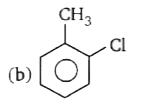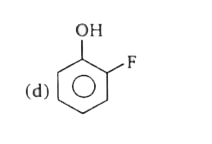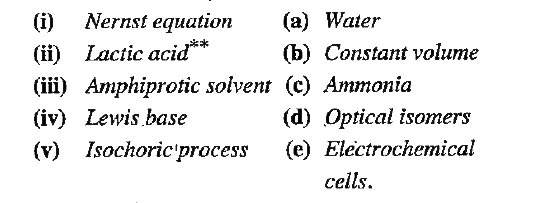In which of the following molecules μexp (observed dipole moment) is found to be greater than μμ (expected dipole moment)?
POCl3

HNC

The correct Answer is:A, B, C, D
To determine in which of the given molecules the observed dipole moment (μexp) is greater than the expected dipole moment (μμ), we need to analyze the factors that influence dipole moments in different molecular structures.
1. Understanding Dipole Moment:
- The dipole moment is a measure of the separation of positive and negative charges in a molecule. It depends on two main factors: the magnitude of the charge and the distance between the charges.
2. Identifying the Molecules:
- We need to consider the molecular structures of the given compounds (like POCl3, CH3Cl, HCl, etc.) and their electronegativities.
3. Analyzing POCl3:
- In POCl3, phosphorus (P) is bonded to three chlorine (Cl) atoms and one oxygen (O) atom. Chlorine is more electronegative than phosphorus, and oxygen is the most electronegative. The dipole moments from the P-Cl bonds and the P-O bond will not completely cancel each other due to the molecular geometry (trigonal pyramidal). This results in a net dipole moment that is greater than expected.
4. Analyzing CH3Cl:
- In CH3Cl, chlorine is more electronegative than carbon and hydrogen. The dipole moment from the C-Cl bond is significant, and the presence of dipole-dipole interactions can enhance the observed dipole moment compared to the expected one.
5. Analyzing HCl:
- In HCl, the dipole moment is primarily due to the electronegativity difference between hydrogen and chlorine. The expected dipole moment is straightforward and does not exhibit significant deviations.
6. Analyzing Other Molecules:
- For other molecules (like those involving hydrogen bonding), the observed dipole moment may also be influenced by interactions such as hydrogen bonding, which can lead to a greater observed dipole moment.
7. Conclusion:
- Based on the analysis, POCl3 and CH3Cl are likely candidates where the observed dipole moment is greater than the expected dipole moment due to their molecular structures and interactions. However, POCl3 is a clear example where the geometry leads to a net dipole moment that is greater than expected.
Final Answer:
The molecule in which μexp is found to be greater than μμ is POCl3.
- The dipole moment is a measure of the separation of positive and negative charges in a molecule. It depends on two main factors: the magnitude of the charge and the distance between the charges.
- We need to consider the molecular structures of the given compounds (like POCl3, CH3Cl, HCl, etc.) and their electronegativities.
- In POCl3, phosphorus (P) is bonded to three chlorine (Cl) atoms and one oxygen (O) atom. Chlorine is more electronegative than phosphorus, and oxygen is the most electronegative. The dipole moments from the P-Cl bonds and the P-O bond will not completely cancel each other due to the molecular geometry (trigonal pyramidal). This results in a net dipole moment that is greater than expected.
- In CH3Cl, chlorine is more electronegative than carbon and hydrogen. The dipole moment from the C-Cl bond is significant, and the presence of dipole-dipole interactions can enhance the observed dipole moment compared to the expected one.
- In HCl, the dipole moment is primarily due to the electronegativity difference between hydrogen and chlorine. The expected dipole moment is straightforward and does not exhibit significant deviations.
- For other molecules (like those involving hydrogen bonding), the observed dipole moment may also be influenced by interactions such as hydrogen bonding, which can lead to a greater observed dipole moment.
- Based on the analysis, POCl3 and CH3Cl are likely candidates where the observed dipole moment is greater than the expected dipole moment due to their molecular structures and interactions. However, POCl3 is a clear example where the geometry leads to a net dipole moment that is greater than expected.
The molecule in which μexp is found to be greater than μμ is POCl3.
Topper's Solved these Questions
- CHEMICAL BONDING (ADVANCED)BOOK - VK JAISWAL ENGLISHCHAPTER - CHEMICAL BONDING (ADVANCED)EXERCISE - MATCH THE COLUMN
21 Videos
- CHEMICAL BONDING (ADVANCED)BOOK - VK JAISWAL ENGLISHCHAPTER - CHEMICAL BONDING (ADVANCED)EXERCISE - ASSERTION-REASON TYPE QUESTIONS
57 Videos
- CHEMICAL BONDING (ADVANCED)BOOK - VK JAISWAL ENGLISHCHAPTER - CHEMICAL BONDING (ADVANCED)EXERCISE - Level 3
77 Videos
- CHEMICAL BONDING (BASIC)BOOK - VK JAISWAL ENGLISHCHAPTER - CHEMICAL BONDING (BASIC)EXERCISE - SUBJECTIVE PROBLEMS
54 Videos
Similar Questions
Knowledge Check
Match the following:
 AA and DBB and CCC and EDB and E
AA and DBB and CCC and EDB and EWhich of the following molecules has the maximum dipole moment?
ACO2BCH4CNH3DNF3
Which among the following pairs of molecules have zero dipole moment ? .
View SolutionWhich of the following molecules has the maximum dipole moment ?
View SolutionWhich of the following molecule has highest dipole moment?
View SolutionWhich of the following molecule has highest dipole moment?
View SolutionWhich of the following molecule has highest dipole moment?
View SolutionWhich among the following molecules have minimum dipole moment ?
View Solution
